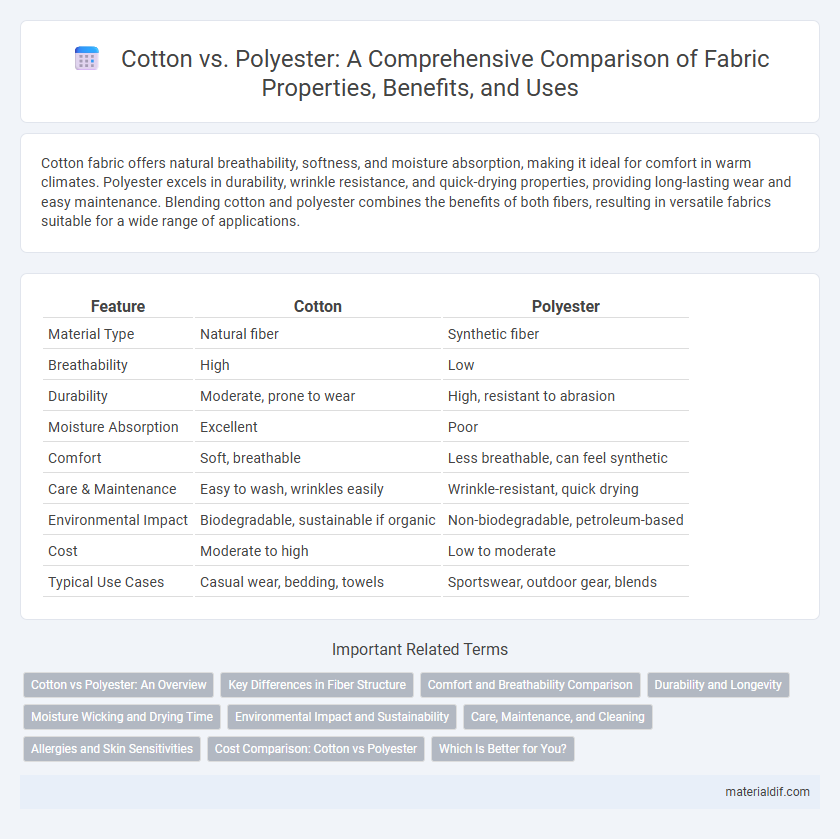Cotton fabric offers natural breathability, softness, and moisture absorption, making it ideal for comfort in warm climates. Polyester excels in durability, wrinkle resistance, and quick-drying properties, providing long-lasting wear and easy maintenance. Blending cotton and polyester combines the benefits of both fibers, resulting in versatile fabrics suitable for a wide range of applications.
Table of Comparison
| Feature | Cotton | Polyester |
|---|---|---|
| Material Type | Natural fiber | Synthetic fiber |
| Breathability | High | Low |
| Durability | Moderate, prone to wear | High, resistant to abrasion |
| Moisture Absorption | Excellent | Poor |
| Comfort | Soft, breathable | Less breathable, can feel synthetic |
| Care & Maintenance | Easy to wash, wrinkles easily | Wrinkle-resistant, quick drying |
| Environmental Impact | Biodegradable, sustainable if organic | Non-biodegradable, petroleum-based |
| Cost | Moderate to high | Low to moderate |
| Typical Use Cases | Casual wear, bedding, towels | Sportswear, outdoor gear, blends |
Cotton vs Polyester: An Overview
Cotton is a natural fiber derived from the cotton plant, known for its breathability, softness, and moisture-wicking properties, making it ideal for comfortable clothing. Polyester, a synthetic fiber made from petrochemicals, offers durability, wrinkle resistance, and quick-drying capabilities, often used in activewear and blends. Comparing cotton and polyester reveals distinctions in comfort, care requirements, and environmental impact, influencing their selection in textile manufacturing.
Key Differences in Fiber Structure
Cotton fibers are natural cellulose-based fibers with a soft, breathable, and moisture-absorbing structure, making them ideal for comfort and durability. Polyester fibers are synthetic polymers derived from petrochemicals, characterized by a smooth, hydrophobic surface and high tensile strength, offering wrinkle resistance and quick-drying properties. The key structural difference lies in cotton's natural, hollow, and fluffy fiber morphology versus polyester's dense, uniform, and plastic-like filaments, influencing texture, breathability, and fabric performance.
Comfort and Breathability Comparison
Cotton fibers naturally absorb moisture and allow air to circulate, providing superior comfort and breathability, especially in warm climates. Polyester, made from synthetic polymers, tends to trap heat and moisture, leading to reduced ventilation and less comfort during prolonged wear. For active or hot-weather use, cotton fabric remains the preferred choice due to its enhanced breathability and softness against the skin.
Durability and Longevity
Cotton offers natural breathability and comfort but tends to wear out faster due to fiber breakage and pilling. Polyester exhibits superior durability with strong synthetic fibers resistant to stretching, shrinking, and abrasions, extending the fabric's lifespan significantly. Combining polyester with cotton in blends enhances fabric longevity by balancing softness with increased resistance to wear and tear.
Moisture Wicking and Drying Time
Cotton fibers absorb moisture, causing the fabric to retain sweat and dry slowly, which can lead to discomfort during physical activities. Polyester is engineered with hydrophobic properties that wick moisture away from the skin and promote rapid evaporation, keeping the wearer dry and comfortable. Performance apparel often utilizes polyester blends to optimize moisture management and accelerate drying time compared to 100% cotton garments.
Environmental Impact and Sustainability
Cotton cultivation requires significant water and pesticide use, leading to soil degradation and high environmental stress, whereas polyester, derived from petroleum, contributes to microplastic pollution and relies on non-renewable resources. Organic cotton offers a more sustainable alternative due to reduced chemical inputs and better soil management, while recycled polyester reduces reliance on virgin fossil fuels but still poses end-of-life recycling challenges. Evaluating the overall lifecycle impacts highlights that sustainable fabric choices must balance water use, chemical inputs, carbon emissions, and waste management for better environmental outcomes.
Care, Maintenance, and Cleaning
Cotton fabric requires gentle washing in cold or warm water to prevent shrinking and fading, benefiting from air drying or low-heat tumble drying to maintain softness. Polyester is more durable in care, tolerating higher washing temperatures and quick drying without losing shape or color, making it resistant to wrinkles and shrinking. Both fabrics demand stain treatment, with cotton absorbing spills more readily and polyester resisting stains but requiring specialized cleaners for oil-based marks.
Allergies and Skin Sensitivities
Cotton fabric is hypoallergenic and breathable, making it ideal for individuals with sensitive skin or allergies, as it reduces irritation and moisture buildup. Polyester, being synthetic, can trap heat and moisture, potentially exacerbating skin sensitivities and causing allergic reactions in some people. Choosing cotton over polyester enhances comfort and minimizes the risk of skin inflammation and allergic responses.
Cost Comparison: Cotton vs Polyester
Cotton fabric typically incurs higher costs due to its natural fiber production and processing requirements, whereas polyester is more affordable because it is synthetically manufactured from petroleum-based products. The price difference influences consumer choices, with polyester offering budget-friendly options for mass-produced garments and cotton favored for premium, breathable textiles. Economic factors such as raw material availability and manufacturing scale also impact the cost disparity between cotton and polyester fabrics.
Which Is Better for You?
Cotton offers superior breathability and natural moisture absorption, making it ideal for sensitive skin and hot climates, while polyester excels in durability, wrinkle resistance, and quick-drying properties suited for activewear and cold weather. Consider your lifestyle needs: choose cotton for comfort and eco-friendliness or polyester for performance and low maintenance. Both fabrics have unique benefits, so your choice depends on factors like sensitivity, climate, and intended use.
Cotton vs Polyester Infographic

 materialdif.com
materialdif.com